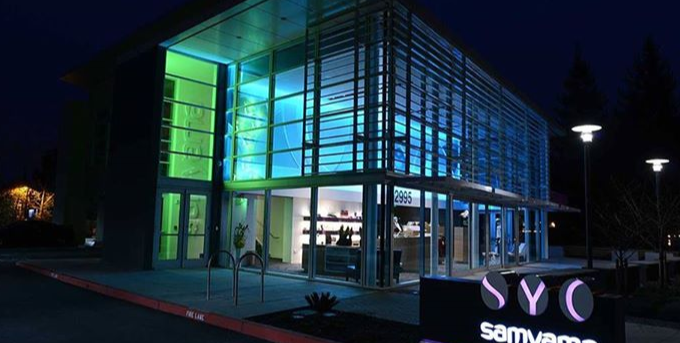John Berg found his life and business calling in yoga. After quickly progressing from a student to a teacher to a teacher of teachers, he opened the Samyama Yoga Center just over a year ago. This yoga haven in Palo Alto has drawn many practitioners to its modern, upscale architecture, the interior of which is John’s creative design. Samyama is his great vision made real, and here is the story of its beginning.
The Start
How did I start doing yoga? I’ll be completely open with you— I am a cancer survivor. I started doing yoga for its healing aspects. I’ve always been athletic, but something in yoga really resonated in me. And one thing about me is if I love something, I’ll inhale it. I took private lessons with an Iyengar master for five years, and I asked him one day if he thought I could teach yoga. He said “I know you will be a teacher someday.” And so I did. I took a teacher’s training program and later I taught as a teacher of that same program. I did well; people like my style— I’m outgoing, I talk a lot…you might call me a bit of a showman. And just as I knew I wanted to teach, I knew I wanted to someday own my own studio.
How did you fund your business in the beginning?
The studio is family funded. I don’t know if you know my dad, Paul Berg. He’s a biochemist who won the Nobel Prize in chemistry. He never pushed me to do science though, and I went into all the areas he didn’t go, like the arts, creative writing, and drama. When I got into yoga, my family saw the change in me. They knew yoga was my calling, and they were supportive. With family funding, I don’t have the limitations of outside funding. Not everyone has that luxury. While Samyama was in the works, most of my lunches with my dad began with “So, I got the latest estimate…” The estimate kept going up because I had such high standards for the construction of the building.
Running the Business
How did you learn to run your business?
Before I opened Samyama, I was teaching at a studio in Menlo Park. The owner asked if I wanted to buy it, but instead I formed a 50/50 partnership – I took care of the art and yoga side while my business partner took care of the business side. I figured that would be a good way to learn how to run a studio before diving into it myself.
What was the biggest mistake you made in the beginning?
I decided it was time to open my own studio when the business partnership I had at the Menlo Park studio dissolved. I will just say that dishonesty ended the partnership. A successful business partnership requires complete honesty.
Who was your first customer?
At Samyama, most of the staff I hired were people I had worked with or trained. They all have some student following. I had a large following in Menlo Park, which is why I originally wanted my studio to be there, but it didn’t work out that way.
What was the smartest thing you did in the beginning?
Once I knew I wanted to someday own a yoga studio, I started making list in my head of all my requirements. When I visited other yoga studios I noted what I liked and didn’t like. From there I knew I wanted my studio to be a free standing building so I wouldn’t have to worry about the neighbors complaining if I cranked up the music. I knew I wanted a two-story building with the studio on the second level so it would be isolated from the comings and goings in the lobby. I wanted the building to have its own parking lot. I wanted there to be showers and lockers for people who needed to clean up and go to work after yoga class. Samyama has all of that.
We also recently received Gold LEED certification. LEED certification (Leadership in Energy and Environmental Design) is a rating system for the environmental sustainability of a building, and Gold certification is rare. It’s something we can shout from the rooftops about, especially to all the neighbors who see the studio lights (which, by the way, are LED) and wonder if we are a nightclub. Getting LEED certified is important, because it means that the studio is environmental and sustainable, and yoga people care about that. Plus it’s best to start with high quality because that minimizes problems later on.
What’s the most surprising thing about running your business?
Finding the dream landlord and location. I originally wanted a studio in Menlo Park. I did find a property in Menlo, but it didn’t work out because I knew I wouldn’t be able to deal with the landlord there. I found another place near a mortuary, and I had fun brainstorming slogans that played with the “spiritual” side of yoga, but that fell through, too.
I was checking out properties in Palo Alto with my real estate agent when he said, "Come with me, I want to show you a place." It was this building. It was just a frame and the landlord was intending to lease it to more than one business occupant. Well, I met the landlord and I signed a 10-year lease for the whole building. My landlord is a dream landlord; he gives me complete freedom to do whatever I want with the building.
What has been the biggest challenge running your own business?
The hardest part of running Samyama is the same as the hardest part of running any business. It’s dealing with people – the managing of all those personalities, insecurities, and needs.
What is the most rewarding thing about running your own business?
What I enjoy most is teaching teachers. There are the teachers who teach by the book and there are the exciting, fun teachers who let you learn for yourself. I don’t want to make John clones. I want to share the discovery of yoga. Yoga is all about personal expression and self-realization. The most gratifying thing is watching teachers graduate and be successful.
What I’ve Learned
What advice do you have for others starting in the this business?
Yoga practitioners are control freaks and yoga teachers are the biggest control freaks because they control the control freaks. Your business is like your baby. It’s hard to let go, but it’s important to empower your staff and give them free reign to make decisions without consulting you every time. I’m not a businessman; I’m more the artistic, creative director of Samyama. I can’t run a studio and teach full-time. That’s why I empower my managers to do what they need to do, so I can do what I do.
About the Author — Sarah is a recent graduate of UC Berkeley where she learned to love the diverse personalities of mom-and-pop stores. She likes intriguing storefronts, creative specialty stores, and well-designed business websites.
This article was originally written on October 28, 2014 and updated on August 25, 2016.



Have at it! We'd love to hear from you and encourage a lively discussion among our users. Please help us keep our site clean and protect yourself. Refrain from posting overtly promotional content, and avoid disclosing personal information such as bank account or phone numbers.
Reviews Disclosure: The responses below are not provided or commissioned by the credit card, financing and service companies that appear on this site. Responses have not been reviewed, approved or otherwise endorsed by the credit card, financing and service companies and it is not their responsibility to ensure all posts and/or questions are answered.